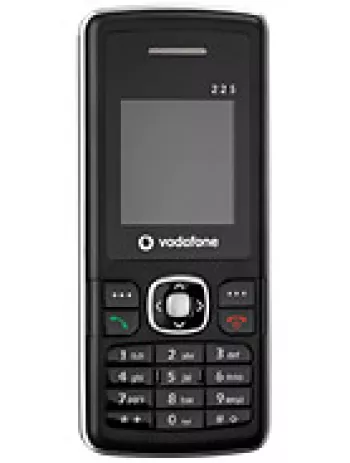Price and specifications of Vodafone 360 H1 advantages, disadvantages, and a comprehensive explanation

Introduction to Vodafone 360 H1
The Vodafone 360 H1 was launched in 2009, marking Vodafone's ambitious step into integrating social networks and telecommunications. A product of collaboration between Vodafone and Samsung, the H1 was designed to seamlessly integrate a wide variety of services and applications to give users a comprehensive mobile experience. Here, we delve into its design, specifications, performance, and much more.
Design and Build
The Vodafone 360 H1 boasts a sleek and modern design with dimensions measuring 115.9 x 58 x 12.9 mm and weighing 134 grams. It fits comfortably in the hand, attributing to its ergonomic form factor. The device uses a Mini-SIM card and features a compact body that was typical of the era.
Display
The H1 comes with a 3.5-inch AMOLED display, delivering vibrant colors and deep contrasts for an engaging visual experience. The resolution of 480 x 800 pixels offers a decent pixel density of approximately 267 ppi, providing clear and sharp images for its time. With a screen-to-body ratio of around 51.9%, the device was well-suited for multimedia consumption.
Operating System and Performance
Under the hood, the Vodafone 360 H1 runs on the LiMo OS. It is powered by a 600 MHz Cortex-A8 processor along with a PowerVR SGX GPU. While modest by today's standards, this setup provided respectable performance for basic smartphone tasks and internet browsing back in 2009.
Camera Capabilities
The main camera of the Vodafone 360 H1 is a 5 MP shooter with autofocus capabilities and an LED flash, enabling low-light photography. It can capture video at 720p resolution at 30 frames per second. The device also features a front camera, suitable for video calls and basic selfies.
Memory and Storage
One of the key features of the 360 H1 was its substantial internal storage of 16GB, which was quite generous during its release. Additionally, the phone supports expandable storage via a dedicated microSDHC card slot, allowing users to further increase storage capacity to suit their needs.
Network and Connectivity
The phone supports a variety of network technologies, including GSM and HSPA, and covers a broad range of 2G and 3G bands. Users could enjoy reliable connectivity and faster data speeds, thanks to its HSPA capabilities. Furthermore, it includes Wi-Fi support (802.11 b/g) and Bluetooth 2.0 with A2DP.
Positioning and Communication
Equipped with GPS and A-GPS, the H1 provides solid navigation capabilities. It also features a stereo FM radio with RDS for users who enjoy listening to live broadcasts. The inclusion of a 3.5mm audio jack allowed users to use their favorite pair of headphones.
Battery Life and Power
The Vodafone 360 H1 was powered by a removable Li-Ion battery, offering a decent standby time of up to 460 hours. It could provide up to 10 hours of talk time on a 2G network and up to 6 hours and 40 minutes on a 3G network. This ensured that users could rely on the device for all-day usage without frequent recharging.
Addition of the 360 Services
What set the Vodafone 360 H1 apart was the integration of Vodafone's 360 services, designed to unify social networking, contacts, and applications in one platform. It aimed to bring together information from social networks, including Facebook and Twitter, into a single address book, providing a streamlined user experience.
Conclusion
In retrospect, the Vodafone 360 H1 was an ambitious endeavor to merge telecommunications and social connectivity. While it might not compete with modern smartphones, it holds a unique place in mobile history. With its combination of hardware and integrated services, the H1 was a noteworthy step in Vodafone's pursuits to enhance mobile user experience.
Key Features of Vodafone 360 H1
- Network Technology: GSM / HSPA
- Display: 3.5 inches AMOLED with 480 x 800 pixels resolution
- Internal Storage: 16GB with microSDHC card slot for expansion
- Main Camera: 5 MP with autofocus and LED flash, capable of 720p video recording
- Selfie Camera: Available
- Processor: 600 MHz Cortex-A8 with PowerVR SGX GPU
- Battery: Removable Li-Ion with up to 460 hours standby time
- Connectivity: Wi-Fi 802.11 b/g, Bluetooth 2.0 with A2DP, GPS and A-GPS
- Audio: 3.5mm jack and stereo FM radio with RDS
- Colors: Available in Black and Silver
Vodafone 360 H1 Drawbacks
- Discontinued status, which means no further official support or updates.
- Utilizes the LiMo OS, which has a limited app ecosystem compared to Android or iOS.
- 600 MHz Cortex-A8 CPU may result in slower performance compared to newer devices.
- The 3.5-inch AMOLED display with 51.9% screen-to-body ratio may feel small by today's standards.
- Lack of advanced sensors, potentially limiting functionality.
- 3G network support (HSPA 2100) is outdated with the current prevalence of 4G and 5G networks.
- Battery life may not suffice for power users, with up to 6 hours 40 minutes of talk time on 3G.
View Also
More Phones
All Rights Reserved +13916 Phones © Mobilawy 2025
























